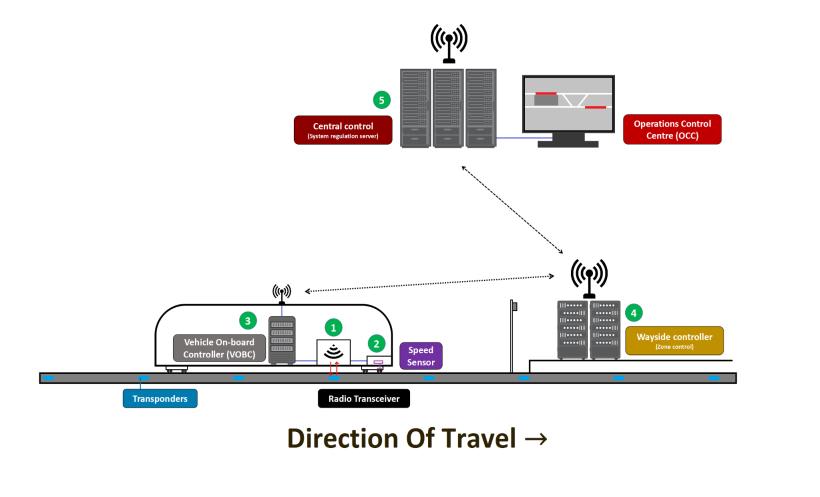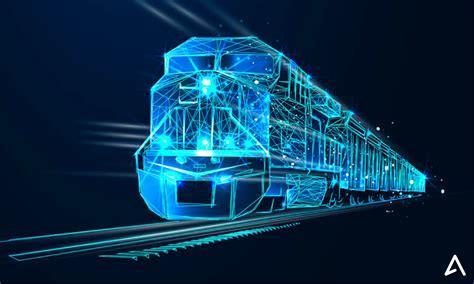
International Research Journal of Engineering and Technology (IRJET) e-ISSN: 2395-0056
Volume: 12 Issue: 01 | Jan 2025 www.irjet.net p-ISSN: 2395-0072


International Research Journal of Engineering and Technology (IRJET) e-ISSN: 2395-0056
Volume: 12 Issue: 01 | Jan 2025 www.irjet.net p-ISSN: 2395-0072
Aman kumar1 , Atul kumar tiwari2
1,2Design
Engineer (Signal and
Telecommunication) ***
Abstract-Railwaysignallingsystemsarepivotalinensuringthesafety,efficiency,andreliabilityoftrainoperations.This paperpresentsacomparativeanalysisofComputer-BasedTrainControl(CBTC)andCommunication-BasedTrainControl (CBTC) systems, highlighting their operational principles, advantages, limitations, and domain-specific applications. By evaluatingtheirsuitabilityforvariousoperationalenvironmentssuchasyards,blocksections,andurbanmetronetworks, thisstudyaimstoprovideinsightsintothebestpracticesfordeployment.Thepaperalsoidentifieskeyinnovations,such as the integration of Artificial Intelligence (AI) and the Internet of Things (IoT), and addresses critical research gaps, including cybersecurity challenges and hybrid system development. These findings contribute to the ongoing modernizationofrailwaysignallingsystems,aligningthemwithglobaladvancements.
Key Words: Train Control Systems, Computer-Based Train Control, Communication-Based Train Control, Railway Signalling,CBTC,CBI,YardOperations,BlockSections,RailwayModernization
1. Introduction:
The railway industry has seen significant advancements in signalling systems to meet growing demands for safety, efficiency, and increased capacity. Among these advancements are the Computer-Based Train Control (CBTC) and Communication-Based Train Control (CBTC) systems, which represent distinct approaches to train operation and management.
Computer-basedsystemsrelyoncentralizedprocessingandfixedblocksignalling,makingthemsuitableforconventional networks.Incontrast,communication-basedsystemsutilizereal-timewirelesscommunicationbetweentrainsandcontrol centers, enabling higher operational flexibility and capacity, particularly in high-density networks. This paper provides a comprehensive review of these systems, comparing their key features, advantages, limitations, and applicability to differentrailwaydomains.
Additionally, this section outlines the evolution of train control systems, tracing the shift from manual signalling to automatedandcommunication-driventechnologies.
2. System Overview:
Theevolutionoftraincontrolsystemshasbeendriven bytheneedtoenhanceoperationalsafety,capacity,andefficiency. Historically,manualsignallingmethodsdominatedtherailwaylandscape,relyingonphysicalsignalsandhumanoperators toensuresafety.Overtime,thesesystemstransitionedtorelay-basedinterlockingsystems,whichintroducedsomelevelof automationbutremainedlimitedinscalabilityandflexibility.Theadventofcomputer-basedsystemsmarkedasignificant leap, enabling centralized control and the use of fixed block signalling to manage train movements. More recently, the introduction of communication-based systems has revolutionized train control by leveraging real-time wireless communication,allowingfordynamicadjustmentsandgreateroperationalefficiency.
2.1 Computer-Based Train Control Systems: Computer-Based Train Control systems utilize centralized computers to managetrainmovementsthroughfixedblocksignalling.Thesesystemsdependheavilyontracksideinfrastructure,suchas signalsandinterlockingsystems,toensureoperationalsafetyandefficiency.
Key Features:
Centralizedprocessingoftraincontroldata.
Fixedblocksignallingdividesthetrackintopredefinedsegments.
Heavyrelianceonphysicalinfrastructure,includingtrackcircuitsandsignals.

International Research Journal of Engineering and Technology (IRJET) e-ISSN: 2395-0056
Advantages:
1. Provenreliabilityinconventionalrailoperations.
2. Cost-effectivefornetworkswithlowtomediumtrafficdensity.
3. Compatibilitywithexistinglegacysystems,reducingtheneedforextensiveupgrades.
Limitations:
1. Limitedcapacityduetotheconstraintsoffixedblocksignalling.
2. Highmaintenancecostsassociatedwithphysicaltracksideinfrastructure.
3. Lackofflexibilityindynamicorhigh-densityoperations.
Applications:
Conventionalpassengerrailsystems.
Freightoperationswithpredictabletrafficpatterns.
Smalltomedium-sizedrailwaynetworks.
2.2 Communication-Based Train Control Systems Communication-BasedTrainControl systemsrepresenta more advancedapproachtorailwaysignalling.Operatingonthemovingblockprinciple,thesesystemsusecontinuouswireless communicationbetweentrainsandcontrolcenterstoenablereal-timedecision-making.
Key Features:
Real-timecommunicationfordynamictraincontrol.
Movingblocksignalling,allowingadaptivetrainspacing.
Advancedautomationcapabilities,includingdriverlessoperations.
Advantages:
1. Enhancedcapacitybyeliminatingfixedblockconstraints.
2. Improvedsafetythroughcontinuousmonitoringandautomatictrainprotection(ATP).
3. Reduceddependencyonphysicaltracksideinfrastructure,loweringlong-termcosts.
Limitations:
1. Highinitialinvestmentincommunicationinfrastructure.
2. Dependenceonrobustwirelessnetworkstoensurereliability.
3. Complexityinintegratingwitholdersignallingsystems.
Applications:
Urbanmetrosystemswithhigh-frequencyoperations.
High-speedrailnetworksrequiringreal-timeadjustments.
Densepassengernetworkswheremaximumcapacityisessential.
Volume: 12 Issue: 01 | Jan 2025 www.irjet.net p-ISSN: 2395-0072 © 2025, IRJET | Impact Factor value: 8.315 | ISO 9001:2008 Certified Journal | Page193

International Research Journal of Engineering and Technology (IRJET) e-ISSN: 2395-0056
Volume: 12 Issue: 01 | Jan 2025 www.irjet.net p-ISSN: 2395-0072

ThisdiagramillustratesthearchitectureofaCommunication-BasedTrainControlsystem,showcasingcomponentssuchas the Vehicle On-board Controller (VOBC), Wayside Controller, Central Control, and Operations Control Center (OCC). Wirelesscommunicationensuresseamlesstrainoperationsandenhancedsafety.
3. Equipment for Train Control Systems
3.1 Equipment for Computer-Based Train Control (CBTC) Systems:
1. Interlocking System: A safety-critical system that monitors the status of railway yard objects, such as track circuitsandswitchpoints,toensurethesafemovementoftrains.
2. Automatic Train Protection (ATP): A safety feature that automatically intervenes to prevent unsafe train movements.
3. Onboard Equipment: Receivescontroldataandtransmitspositiondatatothewaysidezonecontrollerviawired communications.
4. Interlocking Equipment: Processesdatabetweentrainsandgroundsystemstooperateswitchesandsignals.
5. Automatic Train Supervision (ATS): SupervisestheoverallperformanceofCBTCsignallingsystems.
6. Data Communication Equipment: Provides secure and reliable communication channels for critical signalling data.
3.2 Equipment for Communication-Based Train Control (CBTC) Systems:
1. Wayside Communication Units: Enable two-way wireless communication between trains and control centers usingprotocolssuchasGSM-RorLTE.
2. Onboard Communication Modules: Continuouslyupdate train position,speed, andcontrol commandsfor realtimeadjustments.
3. Radio Block Centers (RBC): Managetrainmovementsandtransmitcontroldataoverwirelessnetworks.
4. Train Positioning Systems: UseGPS,sensors,andbalisestoaccuratelydeterminetrainlocation.
5. Automatic Train Operation (ATO): Automates train movements, particularly in urban and high-density environments.
6. Network Management Systems: Ensurerobustandsecurecommunicationacrossconnecteddevices.

International Research Journal of Engineering and Technology (IRJET) e-ISSN: 2395-0056
Volume: 12 Issue: 01 | Jan 2025 www.irjet.net p-ISSN: 2395-0072
4. Technological Innovations in Train Control Systems: Recent technological advancements have revolutionized traincontrolsystems,makingthemsmarterandmoreefficient.ArtificialIntelligence(AI)andMachineLearning(ML)are being employed to optimize scheduling, predict maintenance needs, and detect faults in real-time. Additionally, the InternetofThings(IoT)enablessensorstomonitortraincomponentsandinfrastructure,enhancingsystemreliabilityand safety. For example, the Singapore Mass Rapid Transit (SMRT) system integrates IoT-enabled sensors with AI-driven algorithms to ensure efficient fault detection and predictive maintenance, resulting in significantly reduced downtime. Future innovations, such as 6G networks, promise ultra-low latency communication, further advancing CommunicationBasedTrainControlsystems.Recenttechnologicaladvancementshaverevolutionizedtraincontrolsystems,makingthem smarter and more efficient. Artificial Intelligence (AI) and Machine Learning (ML) are being employed to optimize scheduling, predict maintenance needs, and detect faults in real-time. Additionally, the Internet of Things (IoT) enables sensorstomonitortraincomponentsandinfrastructure,enhancingsystemreliabilityandsafety.Futureinnovations,such as 6G networks, promise ultra-low latency communication, further advancing Communication-Based Train Control systems.

5. Cybersecurity Measures in Communication-Based Systems: As railway systems adopt wireless communication, cybersecurityhasbecomeacriticalconcern.Communication-BasedTrainControlsystemsarevulnerabletothreatssuchas data breaches, denial-of-service attacks, and spoofing. Real-world incidents, such as the ransomware attack on the San Francisco Municipal Transport System in 2016, highlight the potential disruption and financial loss that cybersecurity breaches can cause. Similarly, the attempted hacking of a European railway CBTC system in 2021 underscores the vulnerabilityofwirelessnetworksintraincontrolsystems.
Tocountertheserisks,measureslikeend-to-endencryption,intrusiondetectionsystems,andregularsoftwareupdatesare implemented. Advancedsolutions,including AI-driventhreatdetection,helpidentifyandmitigate potential cyber threats inreal-time.Blockchain-basedsecurecommunicationprotocolsarebeingresearchedtofurtherenhancesecurity,ensuring a robust and resilient infrastructure for modern CBTC systems. As railway systems adopt wireless communication, cybersecurityhasbecomeacriticalconcern.Communication-BasedTrainControlsystemsarevulnerabletothreatssuchas data breaches, denial-of-service attacks, and spoofing. To counter these risks, measures like end-to-end encryption, intrusion detection systems, and regular software updates are implemented. Advanced solutions, including AI-driven threatdetectionandblockchain-basedsecureprotocols,arebeingresearchedtofurtherenhancesecurity.

International Research
Volume: 12 Issue: 01 | Jan 2025 www.irjet.net

6. Comparative Analysis of Key Parameters
Parameter
Block Type
Safety Mechanisms
Computer-Based
Communication-Based
FixedBlock MovingBlock
Signal-based,RedundantSystems
Real-TimeMonitoring Capacity
Automation
Suitability
Freight,Low-DensityNetworks
Metro,High-Speed,High-DensitySystems
7. Discussion The evolution of train control systems reflects the diverse requirements of modern railways. While computer-basedsystemsofferareliablefoundationforconventionalandfreightnetworks,communication-basedsystems excelinhigh-density,dynamicenvironments.However,transitioningtocommunication-basedsystemsinvolveschallenges suchashighcostsandintegrationcomplexities.
Emerging technologies, such as artificial intelligence (AI) and the Internet of Things (IoT), provide opportunities to enhance both systems. AI can improve predictive maintenance, while IoT-enabled sensors facilitate real-time monitoring and decision-making. Hybrid systems combining the strengths of both approaches may offer a balanced solution for evolvingrailwayneeds.
8. Conclusion and Future Directions
This comparative review highlights the strengths and limitations of Computer-Based and Communication-Based Train Control Systems. Computer-based systems are reliable and cost-effective for conventional and freight networks, offering stabilityandcompatibilitywithlegacysystems.Incontrast,communication-basedsystemsexcelinhigh-densityandmetro operationsduetotheirflexibility,increasedcapacity,andreal-timemonitoringcapabilities.
Key findings include:
Communication-based systems provide significant safety and operational advantages through advanced technologieslikemovingblocksignallingandwirelesscommunication.
Computer-based systems remain indispensable for freight and low-density networks where cost considerations andinfrastructurecompatibilityarepriorities.

International Research Journal of Engineering and Technology (IRJET) e-ISSN: 2395-0056
Volume: 12 Issue: 01 | Jan 2025 www.irjet.net p-ISSN: 2395-0072
Emerging technologies such as Artificial Intelligence (AI) and Internet of Things (IoT) have the potential to enhancebothsystems,enablingpredictivemaintenance,faultdetection,andseamlessautomation.
Future research should focus on:
Developing Hybrid Models: Combining the robustness of computer-based systems with the agility of communication-basedsystemstooptimizeperformance.
Advanced Cybersecurity Measures: Addressing vulnerabilities inherent in wireless communication through blockchainandAI-drivensolutions.
AI-Driven Decision-Making: Leveraging AI to further improve operational efficiency, safety, and predictive analytics.
Byintegratingtheseinnovationsandaddressingexistingchallenges,railwaynetworkscanevolveintosafer,moreefficient, and environmentally sustainable systems, meeting the demands of modern transportation. This comparative review highlights the strengths and limitations of Computer-Based and Communication-Based Train Control Systems. Communication-based systems are well-suited for high-density and metro operations, offering superior flexibility and capacity.Computer-basedsystemsremaindependableandcost-effectiveforconventionalandfreightnetworks.
References
[1] RailwaySignallingStandards,IEEE.
[2] InternationalUnionofRailways(UIC)ReportsonTrainControlSystems.
[3] CaseStudiesfromIndianRailwaysandEuropeanMetroSystems.
[4] RecentAdvancesinTrainControlTechnology,IRSEProceedings.
[5] ComparativeStudiesonFixedandMovingBlockSystems,Elsevier.
[6] Kumar, R., & Singh, P. (2022). "Advances in Communication-Based Train Control: A Review." Transportation ResearchProcedia.
[7] Chang, J., et al. (2021). "Cybersecurity Challenges in CBTC Systems." IEEE Transactions on Intelligent TransportationSystems.
[8] Muller, T. (2020). "Integration of AI in Train Control Systems: A European Perspective." Journal of Rail Transport Planning&Management.
[9] Smith, L. & Brown, A. (2019). "IoT Applications in Modern Railway Signalling." International Journal of Railway Technology.
[10] Zhang,Y.,&Li,K.(2023)."EfficiencyImprovementsinCommunication-BasedTrainControl."SpringerAdvancesin TransportationSystems.
[11] RailwaySignallingStandards,IEEE.
[12] InternationalUnionofRailways(UIC)ReportsonTrainControlSystems.
[13] CaseStudiesfromIndianRailwaysandEuropeanMetroSystems.
[14] RecentAdvancesinTrainControlTechnology,IRSEProceedings.
[15] ComparativeStudiesonFixedandMovingBlockSystems,Elsevier.

International Research Journal of Engineering and Technology (IRJET) e-ISSN: 2395-0056
Volume: 12 Issue: 01 | Jan 2025 www.irjet.net p-ISSN: 2395-0072
Aman kumar

An Executive Design Engineer specializing in railway signalling, currently working in the Signal and TelecommunicationDepartmentofaprivateorganization.IearnedmyBachelorofTechnology(B.Tech)in MechanicalEngineeringfromRajivGandhiProudyogikiVishwavidyalaya(RGPV),Bhopal
With over three years of professional experience in railway signalling design, I have developed advanced skillsindesignautomationandsignallingsystems.MytechnicalproficiencywasacknowledgedwhenIwon the gold medal in the Madhya Pradesh State Skill Competition in 2021. Passionate about innovation and precision, I am dedicatedtocontributingtotheadvancementandmodernizationofrailwaysignallingsystems.

A Senior Design Engineer specializing in railway signalling, currently working in the Signal and Telecommunication Department of a private organization. I hold a Bachelor of Technology (B. Tech) in MechanicalEngineeringfromRajivGandhiProudyogikiVishwavidyalaya(RGPV).
Withoverfouryearsofprofessional experience,Ihavedevelopedextensiveexpertiseinrailwaysignalling designsystems.